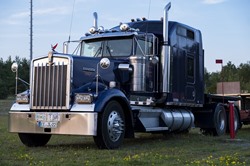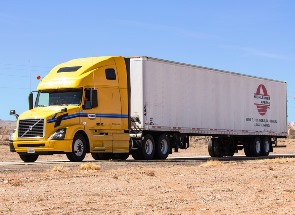How to Select the Best Truck Driving Classes near Wolf Wyoming
 Congrats on your decision to become a trucker and enroll in a truck driving school near Wolf WY. Maybe it has always been your goal to hit the open road while operating a huge tractor trailer. Or perhaps you have done some research and have found that a career as a truck driver offers good income and flexible work opportunities. No matter what your reason is, it’s important to obtain the appropriate training by picking the right CDL school in your area. When assessing your options, there are certain factors that you’ll want to examine prior to making your final choice. Location will certainly be important, especially if you need to commute from your Wolf residence. The cost will also be important, but choosing a school based exclusively on price is not the ideal method to ensure you’ll obtain the proper training. Don’t forget, your objective is to master the skills and knowledge that will enable you to pass the CDL examinations and become a professional truck driver. So keeping that goal in mind, just how do you select a truck driving school? That is what we are going to address in the rest of this article. But first, we are going to talk a little bit about which CDL license you will eventually need.
Congrats on your decision to become a trucker and enroll in a truck driving school near Wolf WY. Maybe it has always been your goal to hit the open road while operating a huge tractor trailer. Or perhaps you have done some research and have found that a career as a truck driver offers good income and flexible work opportunities. No matter what your reason is, it’s important to obtain the appropriate training by picking the right CDL school in your area. When assessing your options, there are certain factors that you’ll want to examine prior to making your final choice. Location will certainly be important, especially if you need to commute from your Wolf residence. The cost will also be important, but choosing a school based exclusively on price is not the ideal method to ensure you’ll obtain the proper training. Don’t forget, your objective is to master the skills and knowledge that will enable you to pass the CDL examinations and become a professional truck driver. So keeping that goal in mind, just how do you select a truck driving school? That is what we are going to address in the rest of this article. But first, we are going to talk a little bit about which CDL license you will eventually need.
Which CDL Will You Need?
 In order to operate commercial vehicles legally within the United States and Wolf WY, a driver must attain a CDL (Commercial Driver’s License). The three license classes that a person can apply for are Class A, Class B and Class C. Given that the subject of this article is how to pick a truck driving school, we will address Class A and Class B licenses. What distinguishes each class of CDL is the kind of vehicle that the driver can operate in addition to the GVWR (Gross Vehicle Weight Rating) or GCWR (Gross Combination Weight Rating). Below are brief summaries of the 2 classes.
In order to operate commercial vehicles legally within the United States and Wolf WY, a driver must attain a CDL (Commercial Driver’s License). The three license classes that a person can apply for are Class A, Class B and Class C. Given that the subject of this article is how to pick a truck driving school, we will address Class A and Class B licenses. What distinguishes each class of CDL is the kind of vehicle that the driver can operate in addition to the GVWR (Gross Vehicle Weight Rating) or GCWR (Gross Combination Weight Rating). Below are brief summaries of the 2 classes.
Class A CDL. A Class A CDL is required to operate any vehicle that has a GCWR of more than 26,000 lbs., including a towed vehicle of more than 10,000 lbs. A few of the vehicles that drivers may be able to operate with Class A licenses are:
- Interstate or Intrastate Tractor Trailers
- Trucks with Double or Triple Trailers
- Tanker Trucks
- Livestock Carriers
- Class B and Class C Vehicles
Class B CDL. A Class B CDL is needed to operate single vehicles having a GVWR of more than 26,000 lbs., or a GCWR of greater than 26,000 lbs. including a towed vehicle weighing up to 10,000 lbs. Several of the vehicles that drivers may be qualified to operate with Class B licenses are:
- Tractor Trailers
- Dump Trucks
- Cement Mixers
- Large Buses
- Class C Vehicles
Both Class A and Class B CDLs might also need endorsements to operate specific kinds of vehicles, for example school or passenger buses. And a Class A license holder, with the proper required endorsements, may operate any vehicle that a Class B licensee is qualified to drive.
Click Here to Get Free Information on Truck Driving Schools Near You!
How to Assess a Trucking School
 Once you have determined which Commercial Drivers License you wish to pursue, you can start the process of researching the Wolf WY truck driving schools that you are considering. As earlier mentioned, cost and location will certainly be your primary considerations. But it can’t be emphasized enough that they should not be your sole concerns. Other factors, for example the reputations of the schools or the experience of the instructors are similarly or even more important. So following are a few additional factors that you should research while performing your due diligence before enrolling in, and especially paying for, your truck driving training.
Once you have determined which Commercial Drivers License you wish to pursue, you can start the process of researching the Wolf WY truck driving schools that you are considering. As earlier mentioned, cost and location will certainly be your primary considerations. But it can’t be emphasized enough that they should not be your sole concerns. Other factors, for example the reputations of the schools or the experience of the instructors are similarly or even more important. So following are a few additional factors that you should research while performing your due diligence before enrolling in, and especially paying for, your truck driving training.
Are the Schools Certified or Accredited ? Not many trucking schools in the Wolf WY area are accredited because of the rigorous process and expense to the schools. On the other hand, certification is more prevalent and is provided by the Professional Truck Driver Institute (PTDI). A school is not required to become certified, but there are a number of advantages. Prospective students know that the training will be of the highest standard, and that they will get an ample amount of driving time. For example, PTDI calls for 44 hours of real driving time, not ride-alongs or simulations. So if a school’s course is certified (the course, not the school is certified), students know that the curriculum and training will satisfy the very high benchmarks set by PTDI.
How Long in Operation? One indicator to help assess the quality of a truck driving school is how long it has been in business. A negatively ranked or a fly by night school usually will not be in business very long, so longevity is a plus. Having said that, even the best of Wolf WY schools had to start from their opening day of training, so use it as one of several qualifiers. You can also find out what the school’s history is relating to successful licensing and employment of its graduates. If a school won’t supply those stats, search elsewhere. The schools should additionally maintain associations with local and national trucking firms. Having a large number of contacts not only confirms a quality reputation within the trade, but also bolsters their job placement program for graduates. It also wouldn’t hurt to check with the Wyoming licensing authority to verify that the CDL trucker schools you are considering are in good standing.
How Effective is the Training? As a minimum requirement, the schools should be licensed in Wyoming and employ instructors that are experienced and trained. We will talk more about the instructors in the following segment. Also, the student to instructor proportion should not be higher than 4 to 1. If it’s any greater, then students will not be obtaining the personalized instruction they will need. This is particularly true regarding the one-on-one instruction for behind the wheel training. And look out for any school that insists it can train you to drive trucks in a relatively short period of time. Learning to be an operator and to drive a tractor trailer professionally takes time. The majority of Wolf WY schools provide training programs that range from three weeks to as long as two months, based on the license class or type of vehicle.
How Experienced are the Trainers? As previously mentioned, it’s essential that the instructors are qualified to teach driving methods and experienced as both drivers and instructors. Even though a number of states have minimum driving time prerequisites to qualify as a teacher, the more professional driving experience an instructor has the better. It’s also vital that the instructors keep current with industry advancements or any new regulations or changes in existing laws. Evaluating instructors might be a little more intuitive than other criteria, and possibly the best approach is to check out the school and talk to the teachers face to face. You can also talk to a few of the students completing the training and find out if they are satisfied with the level of instruction and the teacher’s qualification to train them.
Adequate Driving Time? Most importantly, a good trucking school will furnish ample driving time to its students. Besides, isn’t that what it’s all about? Driving time is the real time spent behind the wheel driving a truck. Although the use of ride-a-longs with other students and simulators are essential training tools, they are no alternative for real driving. The more instruction that a student receives behind the wheel, the better driver he or she will be. Although driving time can vary between schools, a reasonable standard is a minimum of 32 hours. If the school is PTDI certified, it will provide no less than 44 hours of driving time. Check with the Wolf WY schools you are researching and find out how much driving time they furnish.
Are they Captive or Independent ? You can receive free or discounted training from some truck driving schools if you make a commitment to drive for a specified carrier for a defined amount of time. This is what’s known as contract training, and the schools that provide it are called captives. So instead of maintaining relationships with many different trucking lines that they can refer their students to, captives only work with one company. The tradeoff is receiving free or less expensive training by surrendering the flexibility to initially work wherever you have an opportunity. Obviously contract training has the potential to limit your income prospects when starting out. But for some it may be the only way to obtain affordable training. Just be sure to find out if the Wolf WY schools you are considering are independent or captive so that you can make an informed decision.
Provide CDL Testing Onsite? There are several states that will allow 3rd party CDL testing onsite of truck driving schools for its graduates. If onsite testing is allowed in Wyoming, find out if the schools you are looking at are DMV certified to offer it. One benefit is that it is more accommodating than competing with graduates from other schools for test times at Wyoming testing locations. It is moreover an indicator that the DMV views the authorized schools to be of a higher quality.
Are the Classes Flexible? As earlier noted, truck driver training is only about one to two months long. With such a brief term, it’s important that the Wolf WY school you enroll in provides flexibility for both the curriculum and the scheduling of classes. As an example, if you’re having a hard time learning a particular driving maneuver, then the instructor should be willing to dedicate more time with you until you have it mastered. And if you’re still working while going to training, then the class scheduling must be flexible enough to accommodate working hours or other obligations.
Is Job Placement Provided? As soon as you have received your commercial driver’s license after graduating from truck driving school, you will be impatient to begin your new career. Make sure that the schools you are reviewing have job assistance programs. Ask what their job placement ratio is and what average salary their grads start at. Also, ask which national and local trucking firms their graduates are placed with for hiring. If a school has a poor job placement rate or few Wolf WY employers recruiting their grads, it might be a clue to search elsewhere.
Is Financial Aid Provided? Trucking schools are similar to colleges and other Wolf WY area technical or vocational schools when it comes to loans and other forms of financial assistance being offered. Find out if the schools you are reviewing have a financial assistance department, or at least someone who can help you understand the options and forms that need to be completed.
Tractor Trailer Training Wolf Wyoming
 Selecting the appropriate truck driver school is an important first step to starting your new vocation as a long distance or local truck driver. The skills taught at school will be those that forge a new career behind the wheel. There are a number of options offered and understanding them is crucial to a new driver’s success. You originally came to our website because of your interest in Tractor Trailer Training and wanting information on the topic School For Truck Driving. But first and foremost, you must receive the necessary training in order to drive a big commercial vehicle in a professional and safe manner. If you are lacking money or financing, you may need to think about a captive school. You will pay a lower or even no tuition in exchange for driving for their contracted carrier. Or you can select an independent trucker school and have the option of driving for the trucking firm of your choice, or one of many associated with the school. It’s your decision. But no matter how you receive your training, you will in the near future be part of an industry that helps our country move as a professional trucker in Wolf WY.
Selecting the appropriate truck driver school is an important first step to starting your new vocation as a long distance or local truck driver. The skills taught at school will be those that forge a new career behind the wheel. There are a number of options offered and understanding them is crucial to a new driver’s success. You originally came to our website because of your interest in Tractor Trailer Training and wanting information on the topic School For Truck Driving. But first and foremost, you must receive the necessary training in order to drive a big commercial vehicle in a professional and safe manner. If you are lacking money or financing, you may need to think about a captive school. You will pay a lower or even no tuition in exchange for driving for their contracted carrier. Or you can select an independent trucker school and have the option of driving for the trucking firm of your choice, or one of many associated with the school. It’s your decision. But no matter how you receive your training, you will in the near future be part of an industry that helps our country move as a professional trucker in Wolf WY.
Truck On in These Other Wyoming Locations
History of wolves in Yellowstone
When Yellowstone National Park was created in 1872, gray wolf (Canis lupus) populations were already in decline in Montana, Wyoming and Idaho.[citation needed] The creation of the national park did not provide protection for wolves or other predators, and government predator control programs in the first decades of the 1900s essentially helped eliminate the gray wolf from Yellowstone. The last wolves were killed in Yellowstone in 1926. After that time, sporadic reports of wolves still occurred, but scientists confirmed that sustainable wolf populations had been extirpated and were absent from Yellowstone during the mid-1900s.[citation needed]
Starting in the 1940s, park managers, biologists, conservationists and environmentalists began what would ultimately turn into a campaign to reintroduce the gray wolf into Yellowstone National Park. When the Endangered Species Act of 1973 was passed, the road to legal reintroduction was clear. In 1995, gray wolves were first reintroduced into Yellowstone in the Lamar Valley. The history of wolves in Yellowstone chronicles the extirpation, absence and reintroduction of gray wolves to Yellowstone, and how the reintroduction was not without controversy or surprises for scientists, governments or park managers.[citation needed]
In 1872, when Yellowstone National Park was created, there was yet no legal protection for wildlife in the park. In the early years of the park, administrators, hunters and tourists were essentially free to kill any game or predator they came across. The gray wolf was especially vulnerable to this wanton killing because it was generally considered an undesirable predator and was being willingly extirpated throughout its North American range. In January 1883, the Secretary of the Interior issued regulations prohibiting hunting of most park animals, but the regulations did not apply to wolves, coyotes, bears, mountain lions and other small predators.[1]
